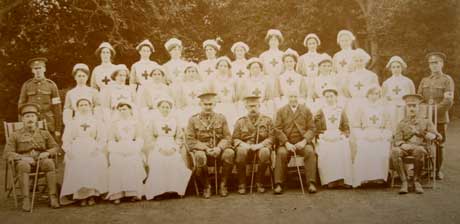 |
King's Own Royal Regiment Museum Lancaster |
|
|
HOME Museum & Collections Sales Donations Events Contact Us REGIMENTAL HISTORY 17th Century 18th Century 19th Century 20th Century First World War Second World War Actions & Movements Battle Honours FAMILY HISTORY Resources Further Reading PHOTO GALLERY ENQUIRIES FURTHER READING LINKS
© Images are copyright, Trustees of the King's Own Royal Regiment Museum. |
Museum Display Information The Great War 1914-1918 Medical Care Medical care was more organised than in any previous war. The scale of casualties with which the system had to cope was far larger than any previously experienced. Nurses of Queen Alexandra’s Military Nursing Service Reserve worked in from August 1914. Many women volunteered for service at both home and abroad to assist the troops.
A soldier wounded at the front would be taken to a First Aid Post by stretcher bearers, to receive immediate attention. From here he could be taken to an Advanced Dressing Station, and then onto a Casualty Clearing Station, a few miles from the front. As much as possible would be done for the wounded here. Each station had a ‘moribund tent’ for those for whom there was no hope.
The road to recovery was often long and slow. Many men were discharged, unfit to fight again. Others were returned to service on the front line.
Sidney Cartmell was a typical wounded soldier. [Wound label, detailing his wounds, and initial treatment] [Letter from a chaplain to a wounded soldiers mother. KO1417/05] [Silver War Badge certificate, issued to discharged soldiers. KO1417/13]
[Sidney Cartmell’s treatment card KO1417/12]
© Images are copyright, Trustees of the King's Own Royal Regiment Museum. Only a proportion of our collections are on display at anyone time. Certain items are on loan for display in other institutions. An appointment is required to consult any of our collections which are held in store. |


